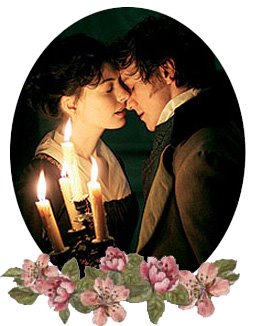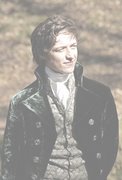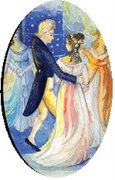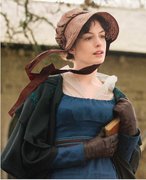Dances in Becoming Jane
 It is the truth universally acknowledged among Jane Austen fans that Jane Austen loved to dance. Her letters to her sister Cassandra showed how the former loved dancing, e.g. as expressed in her letter on December 24, 1798:
It is the truth universally acknowledged among Jane Austen fans that Jane Austen loved to dance. Her letters to her sister Cassandra showed how the former loved dancing, e.g. as expressed in her letter on December 24, 1798:
‘There were twenty dances, and I danced them all, and without any fatigue. I was glad to find myself capable of dancing so much, and with so much satisfaction as I did; from my slender enjoyment of the Ashford balls (as assemblies for dancing) I had not thought myself equal to it, but in cold weather and with few couples I fancy I could just as well dance for a week together as for half an hour. My black cap was openly admired by Mrs. Lefroy, and secretly I imagine by everybody else in the room.’
In fact, Austen’s first surviving letter (January 9, 1796) described her first interactions with Tom Lefroy through dancing:
‘You scold me so much in the nice long letter which I have this moment received from you, that I am almost afraid to tell you how my Irish friend and I behaved. Imagine to yourself everything most profligate and shocking in the way of dancing and sitting down together. I can expose myself however, only once more, because he leaves the country soon after next Friday, on which day we are to have a dance at Ashe after all. He is a very gentlemanlike, good-looking, pleasant young man, I assure you. But as to our having ever met, except at the three last balls, I cannot say much; for he is so excessively laughed at about me at Ashe, that he is ashamed of coming to Steventon, and ran away when we called on Mrs. Lefroy a few days ago.’
According to family records, Jane Austen excelled in dancing and sometime took the role of the leading lady who started the dance (‘I opened the ball with Edward Bridges’ - Austen’s letter on September 5, 1796). Apparently, she was also considered as a popular dance partner, as observed in the following paragraph from Austen’s letter on January 9, 1796:
‘I danced twice with Warren last night, and once with Mr. Charles Watkins, and, to my inexpressible astonishment, I entirely escaped John Lyford. I was forced to fight hard for it, however.’
Austen’s aficionado towards dancing was often reflected in her novels; in fact, none of her novels were devoid of dancing scenes, including Sense & Sensibility (1811), although the dance in this novel was not conducted by the hero(s) and heroine(s) as a couple.
During Austen’s time, dance was an excellent tool for match-making and socialising. In the 18th century, English dance consisted of traditional ‘country dance’, minuets, European dances such as the waltz (which was considered rather improper due to the close physical contact with the partner) and sometimes Boulangeries (a type of French dance, see Austen’s letter dated September 5, 1796). However, dances performed in assembly rooms were usually minuets and the traditional country dance; both dances adhere to the rule of only holding one’s partner by the hand and at arm’s length. A ball usually began with minuet, a more stately and elegant form of dance performed in similar fashion to the country dance, yet danced in the same steps regardless of the tunes. In minuets, couples performed a two-line set and began to dance their way up the row as the leading couple danced down the set. Every couple who had reached the top row would then have to turn and dance down as well. The set in minuets could be very long, ergo giving the couples the (sometimes long-awaited) chance to converse without anyone’s notice (not even the chaperon’s). Balls in Pride & Prejudice (1995, 2005) had such minuets, in which Elizabeth Bennet and Mr. Darcy had the opportunity (or rather, adversity) of somewhat frosty conversations due to the latter’s indifferent demeanour. See this link to learn how to dance Mr. Beveridge’s Maggot, the famous country dance number in Pride & Prejudice (1995) and Emma (1996).
A ball usually began with minuet, a more stately and elegant form of dance performed in similar fashion to the country dance, yet danced in the same steps regardless of the tunes. In minuets, couples performed a two-line set and began to dance their way up the row as the leading couple danced down the set. Every couple who had reached the top row would then have to turn and dance down as well. The set in minuets could be very long, ergo giving the couples the (sometimes long-awaited) chance to converse without anyone’s notice (not even the chaperon’s). Balls in Pride & Prejudice (1995, 2005) had such minuets, in which Elizabeth Bennet and Mr. Darcy had the opportunity (or rather, adversity) of somewhat frosty conversations due to the latter’s indifferent demeanour. See this link to learn how to dance Mr. Beveridge’s Maggot, the famous country dance number in Pride & Prejudice (1995) and Emma (1996).
The second ball in Becoming Jane in Lady Gresham’s manor also began with a minuet, in which Jane Austen half-heartedly danced with Mr. Wisley. Many movie fans praised the particular scene, for in this scene one would enjoy a perfectly choreographed dance in which Tom Lefroy suddenly ‘appeared out of nowhere’ in front of the gloomy Jane. The set in the particular dance was rather long; hence Jane could not see Tom’s presence beforehand (even though she had looked for him earlier). I used the minuet scene in Becoming Jane in Chapter 8 (Dance of the Heart) of Becoming Jane: the Vignette, with the courtesy of Rachel’s beta editing.
English country dance was sometimes performed in a circle, but more often in a set consisted of several couples facing each other (the number of couples could increase depending on the situation and room capacity – as in the party the Dashwood sisters attended in Sense & Sensibility 1995). As in minuets, country dance involved each couple working their way from top to bottom (or bottom-up if they were down the bottom) of the set and, all the way, dancing with every other couple in turn until they returned to the original position or until the music stopped. In such a fashion, Emma Woodhouse had the opportunity to have one or two turns with Mr. Knightley, although her dancing partner was Frank Churchill and Mr. Knightley was actually Harriet Smith’s partner (Emma 1996). Tom Lefroy and Jane Austen also performed the country dance during the Basingstoke Assembly, where the couple incessantly criticised each other’s flaws.
Music to country dance in Basingstoke Assembly had similar quick and merry tones with the ones Elinor Dashwood had in London when she accidentally met Willoughby in the same room (Sense & Sensibility 1995). In the London dance, Elinor could not detect Willoughby’s presence first hand due to the length of the dancing set; the way Jane did not initially see Tom during the second dance in Lady Gresham's manor. Nonetheless, Elinor meeting Willoughby produced very uncomfortable and undesirable effects to both parties (plus Marianne later), as opposed to the delight of Jane when Tom suddenly appeared in front of her.
There were several occasions when a gentleman could breach the etiquette of dancing; i.e. when he did not dance when a lot of young women standing idly, when he refused a lady’s invitation to dance yet afterwards danced with another person or when he left the dance floor before the dance was finished. In Becoming Jane, Jane heavily criticised Tom Lefroy who did not dance with any women at all during the Basingstoke Assembly, despite the unequivocal evident that there were many women who did not have a partner that time. An amusing scene, for Tom was actually standing behind her, listening to all her complains.
For further reading, see Wikipedia’s English Country Dance and Regency Dance and Balls and Dances in Jane Austen’s Day (Jane Austen’s World). The edited version of this article is already posted in Wikipedia.
Reference:
Chapman, R. W. 1979. Jane Austen's Letters to Her Sister Cassandra and Others, 2nd edn, Oxford University Press, Oxford.
Jones, V. 2003, 'Dancing (Appendix C)', in Jane Austen Persuasion, ed. J. Kinsley, Oxford University Press, Oxford, pp. 219-222.
Saskiruleseva, 2007, Favourite expressions [Online], IMDB Available: http://www.imdb.com/title/tt0416508/board/flat/72539275?p=1.
Pic1 & 5: www.annie-hathaway.com
Pic 2: Basingstoke Assembly from Jane Austen's Regency World Magazine March 2007
Pic 3: Elizabeth Bennet (Keira Knightley) & Mr. Darcy (Matthew Macfayden) in Pride & Prejudice (2005)
Pic 4: Caricature of a "longways" country dance by Rowlandson, 2nd half of the 1790's, Wikipedia












































4 comments:
Well, thank you for the shout out. Your article is immensely interesting and wonderful. I see where your blog is going. It is more than the movie. It will explain the manners and customs as well. Bravo!
Thank YOU Ms. Place for the comment and your cool article as well. Yeah, we do not intend to only discuss the movie; Rachel is doing a summary of JA's juvenilia and we are also doing summaries of her books. I daresay your site helps me a lot as well. Thanks!
A huge thaks Ms Place for your kind comments. Our intention is to review all aspects of Jane Austen; her life and of course the wonderful film adaptation that we love so very much.
Your praise makes it so much more enjoyable. Thank you again.
Well, I say, the more the merrier. Your insights dovetail so well with the other blogs. I think that once you are a Jane Austen fan, your curiosity about her and her world is insatiable. You are both doing a wonderful job and I look forward to reading your posts.
Post a Comment